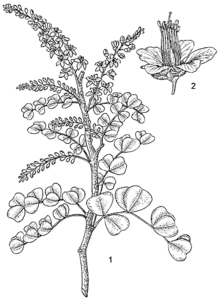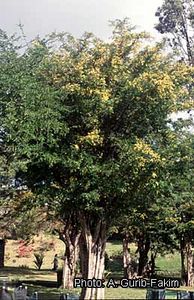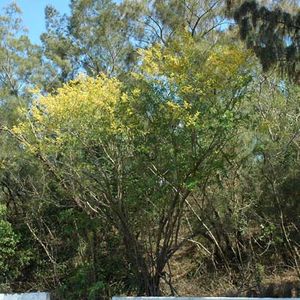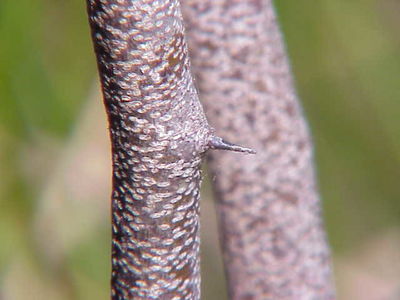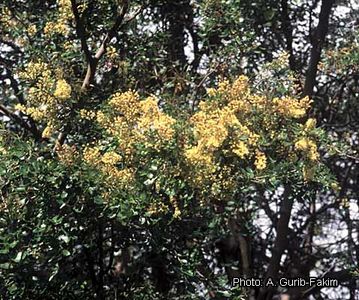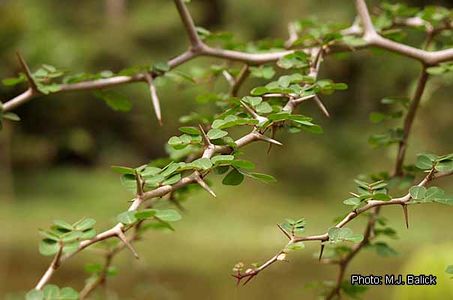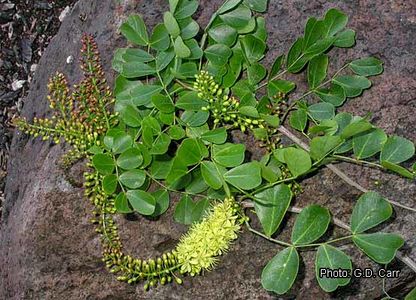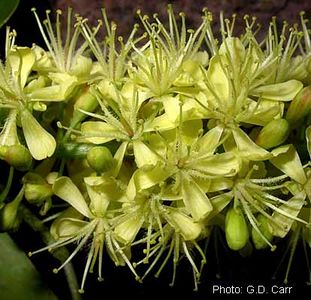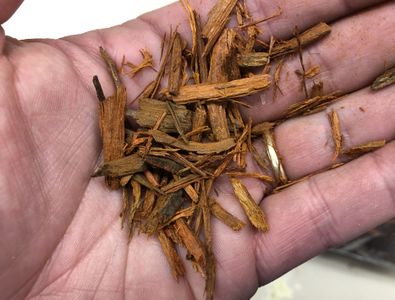Haematoxylum campechianum
Haematoxylum campechianum L.
| Ordre | Fabales |
|---|---|
| Famille | Fabaceae |
| Genre | Haematoxylum |
2n =
Origine : sud Mexique, Belize,
Guatémala, Honduras
sauvage ou cultivé
| Français | campêchier |
|---|---|
| Anglais | campeche wood |
- bois d'œuvre
- bois de cœur : teinture rouge foncé (campêche),
violette, bleue ou noire - bois de feu, charbon de bois
- planté en haies
- mellifère
- graines comestibles
- source d'encre noire
Sommaire
Description
- arbre atteignant 8 m de haut, avec parfois des branches retombantes ; écorce gris clair
- feuilles de 5-10 cm, courtement pétiolées, à 2-4 paires de folioles, brillantes au-dessus, vert pâle au-dessous, obovales à obcordées, de 1-3 cm, à base en coin, apex arrondi ou profondément émarginé
- grappes de 2-5 cm, à nombreuses fleurs ; pédoncule court
- fleur à fin pédicelle de 4-6 mm ; calice de 3-4 mm, à lobes oblongs-lancéolés et apex aigu, pétales jaunes, étroitement obovales, de 5-6 mm, à apex obtus ; étamines aussi longues que les pétales
- fruit : gousse lancéolée-oblongue, de 2-5 × 0.8-1.2 cm ; valves fines (Flora of China)
Noms populaires
| français | arbre à campêche, bois d’Inde, campêchier, campêche ; bois bleu, bois de Campêche, bois de sang (Mansfeld) |
| anglais | logwood, campeche wood, bloodwood tree ; blackwood, campeachy wood (Mansfeld) |
| allemand | Blauholz, Blutholz, Campecheholz (Mansfeld) |
| espagnol | madera de campeche, palo azul, palo de sangre ; brasil (Costa Rica), palo brasil (Honduras), palo de Campeche (Mexique) (Mansfeld) |
| portugais | pau campeche, pau de sangue (PROTA) |
| maya | ek (Mansfeld) |
| chinois | 采木 - cai mu (Flora of China) |
- Voir l'étymologie de campechianum
Classification
Haematoxylum campechianum L. (1753) ("Campechianum")
Cultivars
Histoire
Usages
L’exportation du bois a commencé au British Honduras en 1638 pour extraire une teinture rouge foncé (bois de cœur) ; elle est restée très active jusqu’à la fin du XIXe siècle. Excellent bois de feu, charbon ; bois lourd, dur, élastique, durable ; poteaux, traverses, rarement menuiserie ; aubier blanc. La principale source de charbon de bois (en Grande-Terre et Marie-Galante). Plante très mellifère. Miel renommé ; haies vives qu’on peut tailler (DUSS) ; résiste bien aux cyclones ; encre noire. L’écorce exsude une gomme rougeâtre. Le bois de cœur contient 10 % d’hématoxyline. Teinture en noir, bleu, violet ; les enfants mangent les graines.
In several tropical countries cultivated (e.g. Mexico, Nigeria, Jamaica) or naturalized. Especially Jamaica has been for a long time the centre of campeachy wood (the logwood of commerce) production. The wood furnished a red dye, yielding together with iron salts a black dye. A series of darker dyes (grey, violet, blue, black) is obtained which serve mainly the dyeing of wool, silk, cotton, jute, synthetic fibres and leather. They are also used as dye for clothes and common prints. Furthermore the dye is used for the manufacture of inks, as histological stain (haematoxylin) and as an indicator for alkaloid titrations. The wood serves the production of furniture and medicinal purposes (Lignum Campechianum, Lignum Haematoxyli). The flowers are the source of an excellent honey. The species is frequently cultivated as hedge plant.
Références
- Dambourney, Louis-Alexandre, 1786 Recueil de procédés et d'expériences sur les teintures solides que nos végétaux indigènes communiquent aux laines & aux lainages. Paris, De l'imprimerie de Ph.-D. Pierres, premier imprimeur ordinaire du roi. 407 p. Voir sur Pl@ntUse
- Rollet, Bernard et coll., 2010. Arbres des Petites Antilles. Tome 1 : Introduction à la dendrologie. 276 p. Tome 2 : Description des espèces. 866 p. + 46 pl. coul. + CD de photos sur l'anatomie du bois. Basse-Terre, ONF. Voir sur Pl@ntUse.
- Roubo, André-Jacob, 1774. L’Art du Menuisier. L’art du menuisier-ébéniste — 3e section de la 3e partie. pp. 768-781. Voir sur Pl@ntUse : Inde et Rouge

